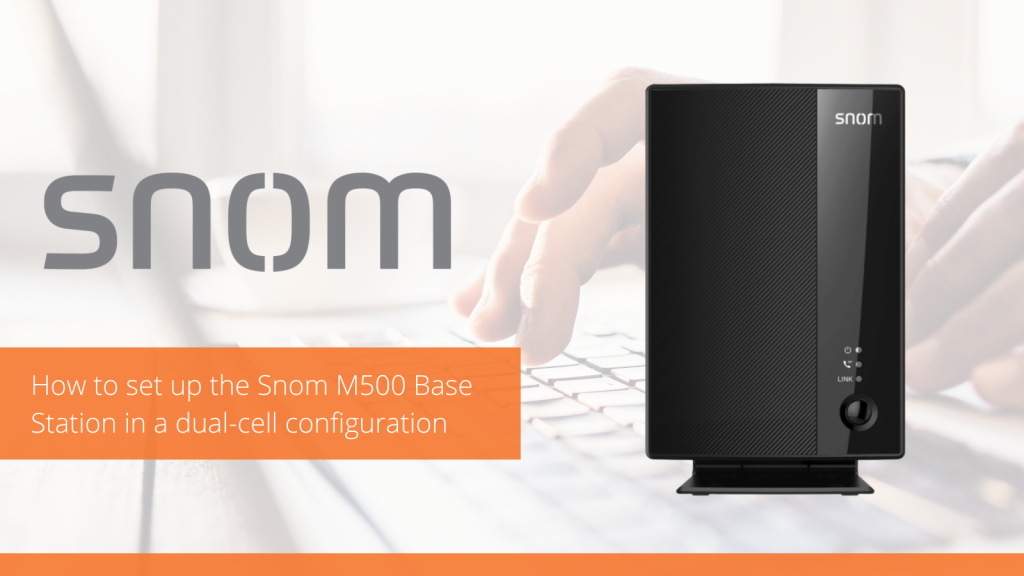How to set up the Snom M500 Base Station in a dual-cell configuration

Snom has introduced their new Snom M5XX DECT Series, which includes the Snom M55 DECT Handset, the Snom M58 DECT Desk Phone, and the Snom M500 Base Station.
The Snom M55 Handset and Snom M58 Desk Phone can be paired to the Snom M500 Base Station. Each Snom M500 Base Station pairs with eight phones and can accept eight calls simultaneously.
To add more calls, easily pair a second base station for an additional eight calls. The M500 Base Station can be set up in a dual-cell configuration. In a dual-cell configuration, two M500 base stations are used. One is a primary base station, and the other is a secondary base station.
This blog will describe how to set up a Snom M500 Base Station in a dual-cell configuration. We will discuss connecting the M500 Base Stations, configuring the M500 Base Stations to dual-cell mode, and checking the site-wide base status.
Connecting the M500 Base Stations
Facility without network infrastructure:
- Plug an Ethernet (network) cable into the RJ45 connector labeled “NET” on the primary base station, and plug the other end into the network side to establish a data link.
- Plug an Ethernet (network) cable into the RJ45 connector labeled “MULTI-CELL” on the primary base station, and plug the other end into the RJ45 connector labeled “NET” on the secondary base station.
Facility with network infrastructure
- Plug an Ethernet (network) cable into the RJ45 connector labeled “NET” on the primary base station, and plug the other end into a network switch to establish a data link.
- Plug an Ethernet (network) cable into the RJ45 connector labeled “NET” on the secondary base station, and plug the other end into a network switch to establish a data link.
Configuring the M500 Base Stations to dual-cell mode
WebUI
1. Open a Web browser. In the address bar, enter the IP address of the primary base station.
2. On the System → Base Preferences page, click the Mode list and select “Primary”.
3. Open a Web browser. In the address bar, enter the IP address of the secondary base station.
4. On the System → Base Preferences page, click the Mode list and select “Secondary”.
5. Repeat step 3-4 for additional base stations.
Provisioning
Import the following setting value to to the primary base station via provisioning.
| multicell.role = primary |
Import the following setting value to to the secondary base station(s) via provisioning.
| multicell.role = secondary |
Checking the Site-wide Base Status
You can check the status of the base station(s) via the WebUI or exporting the configuration file.
WebUI
- Open a Web browser. In the address bar, enter the IP address of any base station in your dual-cell configuration.
- Open the Status → Base Status page.
The table provides a site-wide base listing. The primary base will always be listed as Base 1. All joined secondary base(s) will form the rest of the list. Use the IP and MAC columns to identify the base device.
Provisioning
- Export the configuration file of the primary base station (WebUI: Servicing → Provisioning → Export Configuration → Export button).
- Examine the values of the settings listed below.
“x” = 1 will list the primary base, and “x” starting from 2 will list out all secondary base(s) as each secondary base joins the primary base as part of the site.
| multicell.device.1.ip = 10.91.20.11 multicell.device.1.mac = 000413BB02E0 multicell.device.2.ip = 10.91.20.109 multicell.device.2.mac = 000413BB04C7 |
If you’re looking for more information or have questions, contact one of our VoIP experts at 1-800-398-8647!
Have you used the Snom M5XX DECT Series yet? Have you set up two M500 Base Stations? Let us know by leaving a comment below.